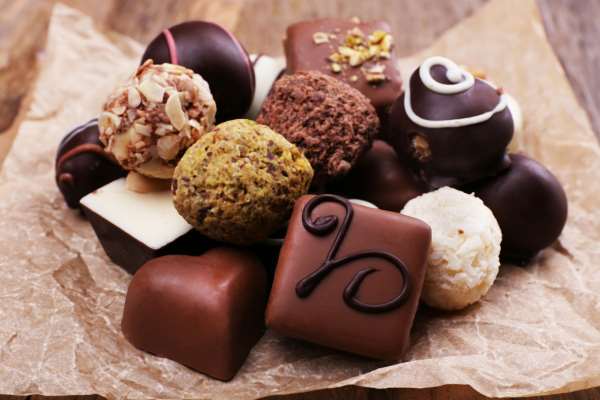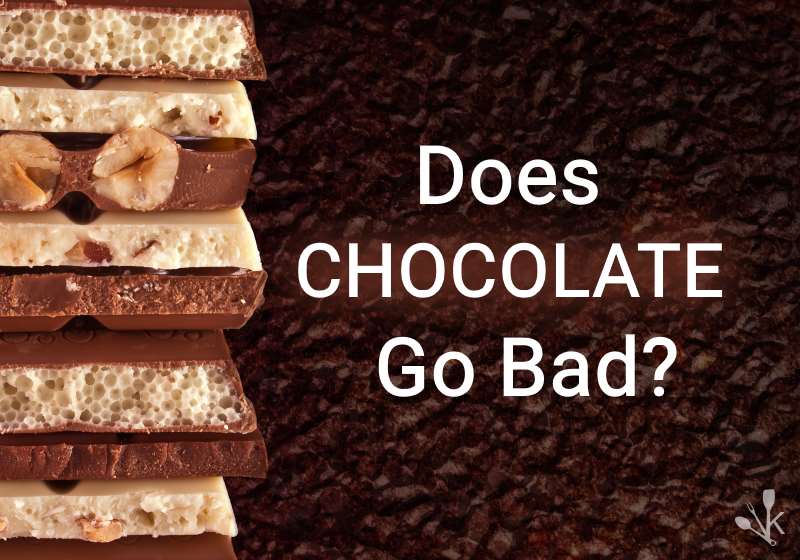Have you ever had the lucky circumstance of coming across a chocolate bar hidden away in the back of a cupboard, well past its expiry date and wondered, does chocolate go bad? If that delicious treat you were saving for a rainy day is covered in white spots, is it still okay to eat?
Chocoholics will be pleased to know that most chocolate blocks will last well past the ‘best before’ date – even in the presence of white film or spots, it’s still perfectly safe to eat.
Dark chocolate lasts around two years when unopened, and well beyond that in the fridge or freezer. Milk or white chocolate will still be delicious for around a year, unopened, and double that when kept cold.
Shelf Life Of Chocolate And Expiration
‘Best before’ dates on chocolate are only a general guide. They indicate how long you have to eat your chocolate while still experiencing the full, rich flavors and that mouth-watering creamy mouth-feel.
In general, chocolate doesn’t turn rancid or go off. However, if stored incorrectly or exposed to unfavorable climates, it may lose some taste and undergo textural or visual changes.
- Dark Chocolate/Baking Chocolate – If unopened and stored correctly, will last around two years. When opened but stored correctly, you can expect it to last around one year in the pantry. Dark chocolate has a lower dairy and sugar content and higher cacao content. These factors help it to last longer than milk or white chocolate. If refrigerated, expect dark chocolate to last around double these times, while in the freezer, it can stay good indefinitely.
- Milk Chocolate/White Chocolate – Stored correctly before opening, it will be in optimal condition for one year. Once unwrapped, it will last for six to eight months when stored in the pantry. Stored in the fridge, milk and white chocolate should stay good for up to two years. In the freezer, indefinitely.
- Chocolate Chips – In the pantry, chocolate chips or pieces will last for around one year unopened. Once opened, they should be okay for around two to four months in the pantry, six to eight months in the fridge, or two to three years in the freezer.
- Truffles – Truffles are usually richer and contain full cream. Therefore they have a much shorter shelf life. You have one to two weeks to consume them before they go bad in the pantry. Refrigerated, they should last for two to three months – you can double this if they are stored in the freezer.
- Chocolate Bars – Often chocolate bars use cheaper fats instead of cocoa butter. These cheap fats oxidize more rapidly, shortening the shelf life. You should consume chocolate bars within two to four months after the ‘best before’ date. This can extend to six months if stored in the fridge, or up to eight months in the freezer.
- Boxed chocolates – After cracking open a box, chocolates should stay good for six to nine months. If kept in the fridge or freezer, they can stay edible for up to one year.
Related | Do Chocolate Chips Go Bad?

Bear in mind that chocolate with additions such as nuts, dried fruit, or other internal fillings won’t last as long. These ingredients can spoil or compromise the inherent properties of the chocolate itself, causing it to go bad. It’s best to abide by ‘best before’ dates in these products.
How To Tell If Chocolate Is Bad
If your chocolate has added ingredients like chopped nuts, fruit, or various fillings, these can turn. Abide by the best before date in these cases.
- Look at your chocolate. A white spot or film is no problem. If you do spot anything approaching a fuzz, or any other color than tannish white, this could be mold and you should throw it out.
- Sniff your chocolate. Cocoa butter is a fat, and fats absorb the odors around them. Even if nearby chocolates are not spoiled, they will have absorbed an unpleasant flavor from the spoiled product.
- Taste test. If you taste anything other than sweet chocolate, or slight bitterness for dark chocolate, better to give it a miss.
Chocolate by itself should not turn rancid or grow mold. However, over time, chocolate will undergo various changes that affect the taste and mouth-feel.
If you are a real chocolate connoisseur and can’t consume chocolate that isn’t perfect, ‘old’ or compromised chocolate can still be used in cooking or baking.
All chocolate is susceptible to “bloom.” Bloom describes the white film or white dots that can form on the surface of chocolate if it is old or exposed to less than ideal conditions. There are two different kinds of bloom.
Sugar bloom is caused by moisture in the packaging that brings sugar crystals to the surface of your chocolate. As it evaporates, it leaves a uniform, white film on the chocolates. This is a common occurrence when storing chocolate in the fridge. Sugar bloom doesn’t impact the texture.
Related | Does Sugar Go Bad?
Fat bloom is more destructive to the integrity of the chocolate. Inconstant storage and changes in temperature produce lighter white spots on the surface of the chocolate. This means that cocoa butter has separated out and risen to the top. This will cause your chocolate to have a crumbly texture.
What Happens If You Eat Expired Chocolate?
Eating expired chocolate will not make you sick, with the exception of chocolates that have other items mixed in that can expire, such peanut butter fillings, nuts etc.
As described above, chocolate that has been undergone temperature changes or gotten old may develop a bloom. This is still perfectly safe to eat.
Chocolate contains flavonoids. These compounds slow down oxidization and prevent chocolate from going rancid. Along with this, there is minimal water content in water. Because bacteria need water to develop, chocolate in itself doesn’t support bacterial growth and won’t make you ill.
The only downside of eating expired chocolate is that it may have lost some of its primary flavors and the texture might be more crumbly than creamy. But chocolate is still chocolate and should never be wasted!
If you really aren’t a fan of the changes your expired chocolate has undergone, there’s still no need to throw it out. You can make use of it for cooking purposes like hot chocolate.
Tips To Make Chocolate Last Longer
Before opening, all varieties of chocolate are best when stored in a cool, dark pantry. Chocolate has a low melting point, so keep it away from any heat sources. The ideal storage temperature is between 65-85 degrees F.
Only refrigerate your chocolate if there is no cool storage spot available – for example if you live in a tropical climate. Refrigeration can cause blooms and change the texture.
Store opened chocolate in an air-tight container in a cool area because:
- Exposing chocolate to a wide variety of temperatures can lead to moisture building up on the surface, causing sugar bloom and leaving white splotches on your chocolate.
- Rapid exposure to multiple temperatures causes fat bloom, leaving unsightly gray splotches and changing the texture of your chocolate.
- The fats in chocolate will pick up the flavor of whatever is around them, including onions, garlic, or leftover pizza.
- Exposure to light can cause chocolate to oxidize, which will impact the look and texture of your chocolates.
- It’s not only humans that have a sweet tooth! Household pests like ants will swarm an opened chocolate bar and make it inedible.
If you will not be consuming your chocolate for a long time, store it in an airtight container in the freezer. It can last indefinitely like this, but some of the intrinsic chocolaty qualities will decline eventually.












